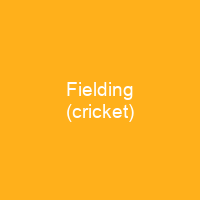Fielding in cricket is the action of fielders in collecting the ball after it is struck by the batsman. The captain of the fielding team must decide which fielding positions to use, and which to leave vacant. Fake fielding is when a fielder makes movements of some of his body parts as if he were fielding only to confuse batsmen into making mistakes. It is now a punishable offence under the ICC rules.
About Fielding (cricket) in brief

With only nine fielders, there are not enough to cover every part of the pitch simultaneously. The main tactical decision for the fielding captain is to strike a balance between setting an attacking field and a defensive field. An attacking field is one in which they are likely to take catches and get the ball in a way that they are most likely to get to get the catch and thus get the wicket. A fielding position is neither fixed nor precisely defined, and fielders can be placed in positions that differ from the basic positions. The nomenclature of the positions is somewhat esoteric, but roughly follows a system of polar coordinates – one word specifies the angle from the batswoman, and is sometimes preceded by an adjective describing the distance from thebatsman. If a fielder wilfully fields it otherwise, the ball becomes dead and five penalty runs are awarded to the batting side, unless the ball previously struck a batsman not attempting to hit or avoid the ball. The area to the left of a right-handed batsman is called the legside or on side, while that to the right is the off side. If the bats man is left-handed, the leg and off sides are reversed and the fielding positions are a mirror image of those shown. The captain may move players between fielding positions at any time except when a bowler is in the act of bowling to a batsmen, though there are exceptions for fielders moving in anticipation of the ball being hit.
You want to know more about Fielding (cricket)?
This page is based on the article Fielding (cricket) published in Wikipedia (as of Nov. 03, 2020) and was automatically summarized using artificial intelligence.







